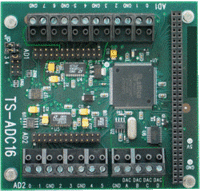TS-7250-V3 TS-ADC16
 | |
| Product Page | |
| alt 16-bit IO |
|---|
The TS-ADC16 provides 16 channels of 16-bit analog to digital conversion at 4 channels of 12-bit digital to analog conversion, 4 digital inputs, 4 16-bit edge counters, and 1 digital output. On the TS-7250-V3 this will support a max sample rate of 16khz with 2 channels enabled.
Refer to the TS-ADC16 manual for register / hardware documentation.
This example assumes only JP3 is installed on the TS-ADC16
# Verify the TS-ADC16 is detected. This should return 0x3E in the lower byte
pc104_peekpoke io alt16 0x100
The TS-ADC16 can FIFO up to 512 samples before it overruns and stops the state machine. For continuous samples the max speed is limited by how fast Linux is able to access this FIFO. If the CPU load is too great that this cannot empty the FIFO fast enough, the ADCDLY should be increased for consistent sampling.
To make Linux more deterministic the governor should be changed to performance:
echo "performance" > /sys/devices/system/cpu/cpufreq/policy0/scaling_governor
The default "ondemand" scheduler is beneficial for power savings, but when the system detects a load and it changes clock speed this can stop Linux from scheduling other processes too long that the FIFO can overflow.
The below sample c code will pull data from the FIFO as fast as possible and output it to stdout in binary form.
#include <stdio.h>
#include <stdint.h>
#include <assert.h>
#include <unistd.h>
#include <time.h>
#include <math.h>
#include "pc104.h"
#define TSADC16_BASE 0x100
#define SAMPLE_SIZE 1024
/*
* The TS-7250-V3
* 1/32000000=31.35ns increments
2000 * 31.35ns = 62.7us. 1/0.0000627 = 15949hz sample rate
*/
#define ADCDLY 2000
/*
* We always sample from the lowest channel to the max channel
* https://docs.embeddedTS.com/TS-ADC16#ADC_pins
*/
#define MAX_CHAN_PAIR 0
int main(int argc, char **argv)
{
uint16_t reg;
int i, fifocnt, ret;
if(isatty(fileno(stdout))) {
fprintf(stderr, "Pipe to a file for raw ADC data\n");
return 1;
}
pc104_init();
if((pc104_io_16_alt_read(TSADC16_BASE) & 0xff) != 0x3E) {
fprintf(stderr, "TS-ADC16 not detected");
return 1;
}
assert(MAX_CHAN_PAIR < 8);
/* Set ADCDLY */
pc104_io_16_alt_write(TSADC16_BASE + 0x4, ((uint32_t)ADCDLY) >> 16);
pc104_io_16_alt_write(TSADC16_BASE + 0x6, ((uint32_t)ADCDLY) & 0xffff);
/* Set ADCCFG
* Trigger with SYSCOM bit
* Single ended
* 0v to 5V */
reg = 0x160 | (MAX_CHAN_PAIR << 1);
pc104_io_16_alt_write(TSADC16_BASE + 0x2, reg);
pc104_io_16_alt_write(TSADC16_BASE + 0x2, reg | 0x1);
do {
reg = pc104_io_16_alt_read(TSADC16_BASE + 0x8);
fifocnt = reg >> 6;
if(!fifocnt) {
reg = pc104_io_16_alt_read(TSADC16_BASE + 0x2);
if(reg & 0x1)
continue;
fprintf(stderr, "Increase ADCDLY, can't keep up\n");
return 1;
}
for (i = 0; i < fifocnt; i++) {
uint16_t buffer = pc104_io_16_alt_read(TSADC16_BASE + 0xa);
ret = write(1, &buffer, sizeof(uint16_t));
assert(ret == sizeof(uint16_t));
}
} while(1);
return 0;
}
This will continuously output raw binary data from the lowest to highest enabled ADC channel.